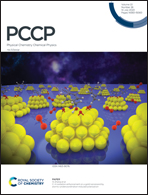Unraveling the enhancement mechanisms of H2S sensing on a SnO2 surface: an ab initio perspective†
Abstract
Accurate and effective sensing of H2S is one of the most complex and challenging tasks. Recent studies have demonstrated that the development of an Sb-doped SnO2 nanoribbon sensor can enhance the detection limit of H2S. To clarify the enhancement mechanism, various factors that regulate the sensing processes, such as the Sb-doped sites, surface oxygen defects and possible pre-adsorbed oxygen species, are considered in this study. Theoretical calculations reveal a thorough and extensive understanding of the gas-sensing mechanisms. Once the H2S gas interacted with the Sb-doped SnO2(110) surface, the molecule released electrons back to the surface, together with a decreased resistance level and strengthened detection signal. In addition, the dissociative adsorption of the O2 molecule also plays a significant role in the sensing processes. It is expected that the present work can provide effective guidance for improving the sensitivity of metal oxide surfaces and shed new light on the development of next generation gas-sensing materials.



 Please wait while we load your content...
Please wait while we load your content...